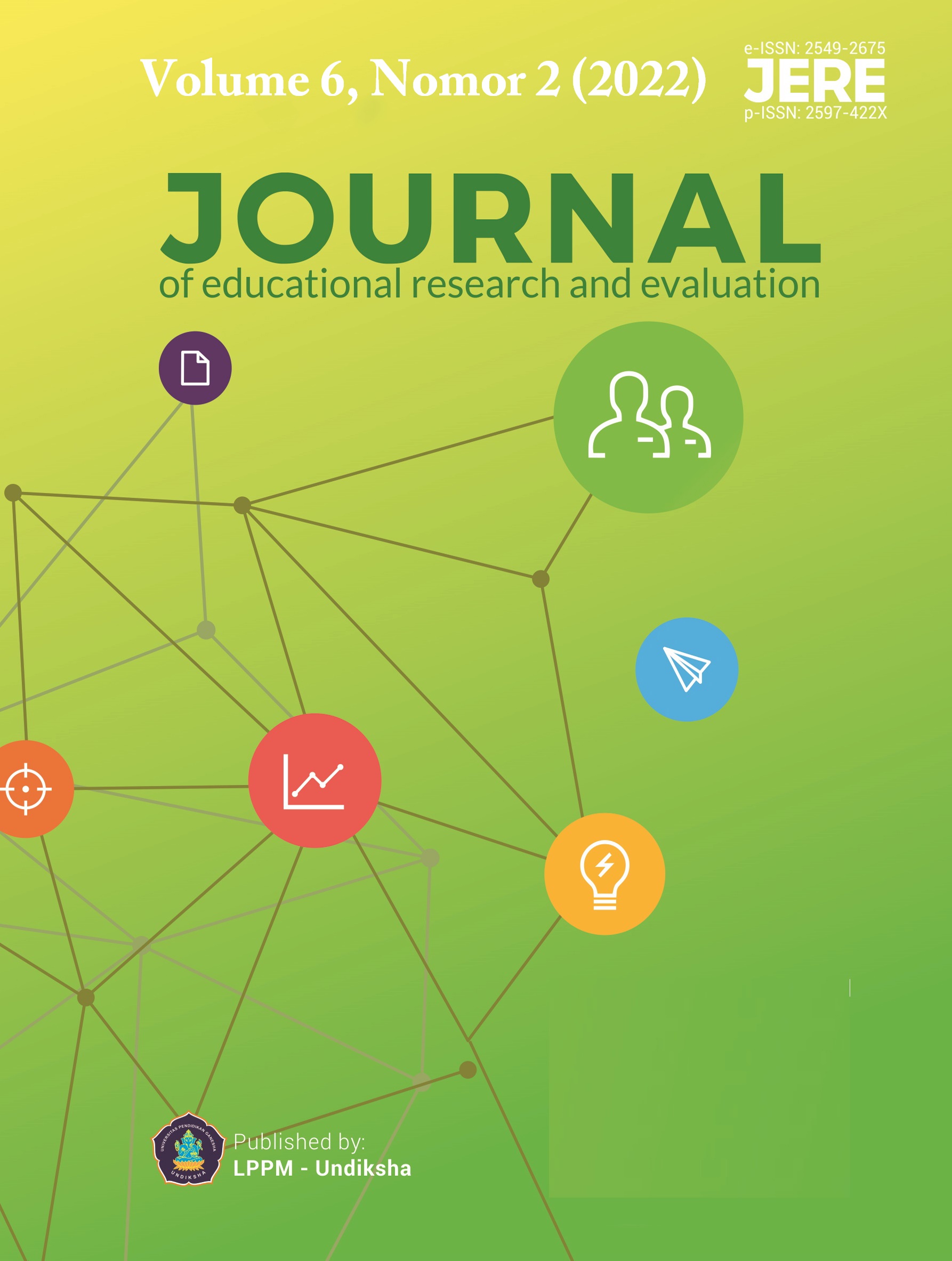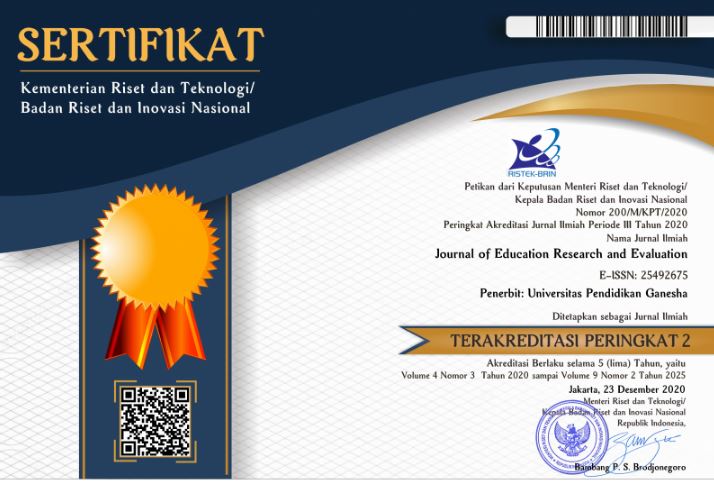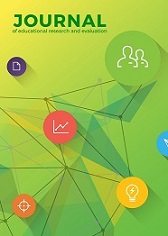Peer Tutoring with Realistic Mathematics Education in Inclusive Class to Improve Problem-Solving Skills
DOI:
https://doi.org/10.23887/jere.v6i2.43651Keywords:
inclusive class, slow learner, peer tutoring, realistic mathematics education, problem-solving skillsAbstract
Many teachers are unprepared to teach special-needs students in inclusive classes. In addition, methods and approaches related to the effectiveness of learning mathematics in inclusive classes have not been explored, especially those related to problem-solving skills. This study aims to analyze the effectiveness of the peer tutoring method with the Realistic Mathematics Education approach to the problem-solving skills of slow learners and inclusive class students. This type of research is a quasi-experimental design with a Group Pretest-Posttest design. The sample of this study was selected by saturated sampling consisting of 31 slow learners and 62 regular students spread over three inclusive classes. Determination of slow learners is based on the results of intelligence tests and student learning outcomes. The instrument used to measure problem-solving skills is an essay in the form of a pretest and posttest. The data analysis technique is descriptive qualitative, quantitative, and inferential analysis. The results showed that the average post-test score was higher than the average pretest score based on problem-solving skills, more than 75% of all students. Get a score higher than the minimum achievement criteria. It shows that the peer tutoring method with the Realistic Mathematics Education approach is effectively applied in inclusive classes for slow learners and general students regarding problem-solving skills.
References
Ahmad, S. S., Shaari, M. F., Hashim, R., & Kariminia, S. (2015). Conducive Attributes of Physical Learning Environment at Preschool Level for Slow Learners. Procedia - Social and Behavioral Sciences, 201(February), 110–120. https://doi.org/10.1016/j.sbspro.2015.08.138.
Ainsworth, S. (2006). DeFT: A conceptual framework for considering learning with multiple representations. Learning and Instruction, 16(3), 183–198. https://doi.org/10.1016/j.learninstruc.2006.03.001.
Al-Zoubi, S. M., & Younes, M. A. B. (2015). Low Academic Achievement: Causes and Results. Theory and Practice in Language Studies, 5(11), 2262. https://doi.org/10.17507/tpls.0511.09.
Alegre, F., Moliner, L., Maroto, A., & Lorenzo-Valentin, G. (2019). Peer tutoring and mathematics in secondary education: literature review, effect sizes, moderators, and implications for practice. Heliyon, 5(9), e02491. https://doi.org/10.1016/j.heliyon.2019.e02491.
Anastasiou, D., Kauffman, J. M., & Di Nuovo, S. (2015). Inclusive education in Italy: description and reflections on full inclusion. European Journal of Special Needs Education, 30(4), 429–443. https://doi.org/10.1080/08856257.2015.1060075.
Bernard, J., Chang, T. W., Popescu, E., & Graf, S. (2017). Learning style Identifier: Improving the precision of learning style identification through computational intelligence algorithms. Expert Systems with Applications, 75, 94–108. https://doi.org/10.1016/j.eswa.2017.01.021.
Bogdan, R., & Biklen, S. K. (1982). Qualitative research for education: An introduction to theory and methods. Allyn and Bacon, Inc.
Cengiz, N., Kline, K., & Grant, T. J. (2011). Extending students’ mathematical thinking during whole-group discussions. Journal of Mathematics Teacher Education, 14(5), 355–374. https://doi.org/10.1007/s10857-011-9179-7.
Chauhan, M. S. (2011). Slow Learners: Their Psychology and Educational Programmes. International Journal of Multidisciplinary Research, 1(8), 279–289. https://www.academia.edu/download/54854309/22_VOL_1_ISSUE8_ZEN.pdf.
Chere, N. E., & Hlalele, D. (2014). Academic underachievement of learners at school: A literature review. Mediterranean Journal of Social Sciences, 5(23), 827–839. https://doi.org/10.5901/mjss.2014.v5n23p827.
Dasaradhi, K., Mandal, M., Dt, K., Mentor, H., & Wing, G. (2016). 30 Methods to Improve Learning Capability in Slow Learners Sriharipuram. International Journal of English Laguage, Litreture and Humanities, 4, 556–570. https://www.researchgate.net/profile/Houda-Kawas/post/How_you_improve_weak_students_in_your_classroom/attachment/59d659fd79197.b80779af405/AS%3A544686570786816%401506874806790/download/60.Dasardhi-paper-final.pdf.
de la Hera, D. P., Zanoni, M. B., Sigman, M., & Calero, C. I. (2022). Peer tutoring of computer programming increases exploratory behavior in children. Journal of Experimental Child Psychology, 216, 105335. https://doi.org/10.1016/j.jecp.2021.105335.
Djamarah, Bahri, & Zain. (2010). Strategi Belajar Mengajar. Rineka Cipta.
Dunne, M., Humphreys, S., Dyson, A., Sebba, J., Gallannaugh, F., & Muijs, D. (2011). The teaching and learning of pupils in low-attainment sets. Curriculum Journal, 22(4), 485–513. https://doi.org/10.1080/09585176.2011.627206.
Elia, I., Panaoura, A., & Eracleous, A. (2007). Relations between secondary pupils’ conceptions about functions and problem solving in different representations. International Journal of Science and Mathematics Education, 5(3), 533–556. https://doi.org/10.1007/s10763-006-9054-7.
Ellis, R., Zhu, Y., Shintani, N., & Roever, C. (2021). A study of Chinese learners’ ability to comprehend irony. Journal of Pragmatics, 172, 7–20. https://doi.org/10.1016/j.pragma.2020.11.003.
Francisco, J. M. (2013). Learning in collaborative settings: Students building on each other’s ideas to promote their mathematical understanding. Educational Studies in Mathematics, 82(3), 417–438. https://doi.org/10.1007/s10649-012-9437-3.
Gravemeijer, K., Doorman, M., & CONTEXT. (2000). Optimal portfolio choice under a liability constraint. Annals of Operations Research, 97(1–4), 131–141. https://doi.org/10.1023/A.
Hermanto. (2010). Penyelenggaraan Pendidikan Inklusif Membutuhkan Keseriusan Manajemen Sekolah. In Jpk: Jurnal Pendidikan Khusus (Vol. 6, Issue 2). https://doi.org/10.21831/jpk.v6i2.6737.
Heuvel-panhuizen, M. Van Den, Drijvers, P., Education, M., Sciences, B., & Goffree, F. (2014). Encyclopedia of Mathematics Education. Encyclopedia of Mathematics Education. https://doi.org/10.1007/978-94-007-4978-8.
Huber, & Carter. (2019). Fostering peer relationships and shared learning for students with autism spectrum disorders,” in The SAGE Handbook of Autism and Educatio (Jordan, Roberts, & Hume (eds.)). Sage. https://doi.org/10.4135/9781526470409.n21.
Istri Aryani, I. G. A., & Rahayuni, N. K. S. (2016). Innovation of Teaching and Learning English Applied to Animal Sciences’ Student with the Combination of Computer Media and Audio Visual. International Journal of Linguistics, Literature and Culture, 2(1). https://doi.org/10.21744/ijllc.v2i1.5.
Kaur, P., Singh, M., & Singh, G. (2015). Classification and prediction based data mining algorithms to predict slow learners in education sector. Procedia - Procedia Computer Science, 57, 500–508. https://doi.org/10.1016/j.procs.2015.07.372.
Khazaal, H. F. (2015). Problem Solving Method Based On E-Learning System For Engineering Education. Journal of College Teaching & Learning (TLC), 12(1), 1–12. https://doi.org/10.19030/tlc.v12i1.9066.
Kim, S. C., Jillapali, R., & Boyd, S. (2021). Impacts of peer tutoring on academic performance of first-year baccalaureate nursing students: A quasi-experimental study. Nurse Education Today, 96(November 2020), 104658. https://doi.org/10.1016/j.nedt.2020.104658.
Lie. (2008). Cooperative Learning Mempraktikkan cooperative learning di ruang-ruang kelas. Grasindo.
Mahoney, M. W. M. (2019). Peer-Mediated Instruction and Activity Schedules: Tools for Providing Academic Support for Students With ASD. Teaching Exceptional Children, 51(5), 350–360. https://doi.org/10.1177/0040059919835816.
Malik, S. (2009). Effect of Intervention Training on Mental Abilities of Slow Learners. International Journal of Educational Sciences, 1(1), 61–64. https://doi.org/10.1080/09751122.2009.11889977.
Mami, S., & Arayesh, B. (2010). Comparative study of educational status and behavioral disorder between slow-learner and normal students of Ilam province (2007-2008). Procedia - Social and Behavioral Sciences, 5, 221–225. https://doi.org/10.1016/j.sbspro.2010.07.076.
Martí, O., Moliner, L., & Alegre, F. (2022). When CLIL is for all: Improving learner motivation through peer-tutoring in Mathematics. System, 106(February), 102773. https://doi.org/10.1016/j.system.2022.102773.
Mawaddah, S., & Anisah, H. (2015). Kemampuan Pemecahan Masalah Matematis Siswa Pada Pembelajaran Matematika dengan Menggunakag) di SMPn Model Pembelajaran Generatif (Generative Learning) di SMP. EDU-MAT: Jurnal Pendidikan Matematika, 3(2), 166–175. https://doi.org/10.20527/edumat.v3i2.644.
Muppudathi, G., Education, A., John, S., & College, D. B. (2014). Role of Teachers on Helping Slow Learners to Bring Out Their Hidden Skills. Ijsr -International Journal of Scientific Research, 3(2277), 98–99. https://www.academia.edu/download/34288348/Role_of_Teachers_on_Helping_Slow_Learners_to_Bring_out_their_Hidden_Skills.pdf.
Mwei, P. K. (2017). Problem solving: How do in-service secondary school teachers of mathematics make sense of a non-routine problem context? International Journal of Research in Education and Science, 3(1), 31–41. https://doi.org/10.21890/ijres.267368.
Pramitasari, K., Usodo, B., Subanti, S., Magister, P., Matematika, P., Sebelas, U., & Surakarta, M. (2019). Proses Pembelajaran Matematika Untuk Siswa Slow Learner Di Kelas Inklusi Smp Negeri 7 Klaten Kelas Viii. Jurnal Elektronik Pendidikan Matematika, 3(7), 777–786. https://jurnal.fkip.uns.ac.id/index.php/s2math/article/view/6494.
Prayoga, I. G. P. A., Ratminingsih, N. M., & Budasi, I. G. (2015). The Effect of Scripted Songs as a Teaching Technique on English Competence of 4th Grade Students of Primary School in SD Saraswati Tabanan in Academic Year 2013/2014. International Journal of Linguistics, Literature and Culture, 1(1), 15. https://doi.org/10.21744/ijllc.v1i1.102.
Pugatch, T., & Wilson, N. (2018). Economics of Education Review Nudging study habits : A fi eld experiment on peer tutoring in higher. 62(November 2017), 151–161. https://doi.org/10.1016/j.econedurev.2017.11.003.
Rogowsky, B. A., Calhoun, B. M., & Tallal, P. (2015). Matching learning style to instructional method: Effects on comprehension. Journal of Educational Psychology, 107(1), 64–78. https://doi.org/10.1037/a0037478.
Ryve, A., Larsson, M., & Nilsson, P. (2013). Analyzing Content and Participation in Classroom Discourse: Dimensions of Variation, Mediating Tools, and Conceptual Accountability. Scandinavian Journal of Educational Research, 57(1), 101–114. https://doi.org/10.1080/00313831.2011.628689.
Sani Abdurrahman, M., & Musa Garba, I. (2014). Influence of Laboratory Activities and Peer Tutoring on Slow-Learners Achievement and Retention in Senior Secondary School Trigonometry, Kebbi State Nigeria. IJOAR .Org International Journal of Advance Research, 2(12), 1–17. https://citeseerx.ist.psu.edu/viewdoc/download?doi=10.1.1.680.3256&rep=rep1&type=pdf.
Sari, I. P. (2019). Peningkatan Kemampuan Pemecahan Masalah Matematis Siswa SMP Melalui Pendekatan Saintifik Problem posing. Jurnal Pendidikan Matematika, 9(1), 114. https://doi.org/10.36709/jpm.v9i1.5766.
Sarid, M., Meltzer, Y., & Raveh, M. (2020). Academic Achievements of College Graduates With Learning Disabilities Vis-a-Vis Admission Criteria and Academic Support. Journal of Learning Disabilities, 53(1), 60–74. https://doi.org/10.1177/0022219419884064.
Schunk, D. H. (1995). The Global Geospace Science Program and its investigations. In Space Science Reviews (Vol. 71, Issues 1–4). https://doi.org/10.1007/BF00751323.
Sclafani, S. (2007). The no child left behind act: Political context and national goals. Assessing Mathematical Proficiency, 23–28. https://doi.org/10.1017/CBO9780511755378.005.
Scruggs, & Mastropierim. (2009). he inclusive classroom: Strategies for effective instruction 4th Edition. Merrill/Prentice Hall.
Sh, S., Felani, M., Hashim, R., & Kariminia, S. (2015). Conducive Attributes of Physical Learning Environment at Preschool Level for Slow Learners. Procedia - Social and Behavioral Sciences, 201(February), 110–120. https://doi.org/10.1016/j.sbspro.2015.08.138.
Shaw, S. (2010). Rescuing students from the slow learner trap. Principal Leadership, 10(6), 12–16. https://eric.ed.gov/?id=EJ894654.
Shokoohi-Yekta, M., Zamani, N., & Ahmadi, A. (2011). Anger management training for mothers of mildly mentally retarded and slow learner children: Effects on mother-child relationship. Procedia - Social and Behavioral Sciences, 15, 722–726. https://doi.org/10.1016/j.sbspro.2011.03.172.
Soucy McCrone, S. (2005). The Development of Mathematical Discussions: An Investigation in a Fifth-Grade Classroom. Mathematical Thinking and Learning, 7(2), 111–133. https://doi.org/10.1207/s15327833mtl0702_2.
Suryasa, I. W., Prayoga, I. G. P. A., & Werdistira, I. W. A. (2017). An Analysis of Students’ Motivation Toward English Learning As Second Language Among Students In Pritchard English Academy (PEACE). International Journal of Social Sciences and Humanities (IJSSH), 1(2), 43. https://doi.org/10.21744/ijssh.v1i2.36.
Thurston, A., Roseth, C., Chiang, T.-H., Burns, V., & Topping, K. J. (2020). The influence of social relationships on outcomes in mathematics when using peer tutoring in elementary school. International Journal of Educational Research Open, 1(May), 100004. https://doi.org/10.1016/j.ijedro.2020.100004.
Tripathi, P. N. (2017). Multiple representations, III. Pedagogy and Content in Middle and High School Mathematics, 13(8), 277–287. https://doi.org/10.1007/978-94-6351-137-7.
Webb, N. M. (2009). The teacher’s role in promoting collaborative dialogue in the classroom. British Journal of Educational Psychology, 79(1), 1–28. https://doi.org/10.1348/000709908X380772.
Zhang, Y., & Chu, S. K. W. (2016). New ideas on the design of the web-based learning system oriented to problem solving from the perspective of question chain and learning community. International Review of Research in Open and Distance Learning, 17(3), 176–189. https://doi.org/10.19173/irrodl.v17i3.2115.
Downloads
Published
How to Cite
Issue
Section
License
Copyright (c) 2022 Sumbaji Putranto, Marsigit Marsigit, Gamarina Isti Ratnasari

This work is licensed under a Creative Commons Attribution-ShareAlike 4.0 International License.
Authors who publish with the Journal of Evaluation and Research in Education (JERE) agree to the following terms:
- Authors retain copyright and grant the journal the right of first publication with the work simultaneously licensed under a Creative Commons Attribution License (CC BY-SA 4.0) that allows others to share the work with an acknowledgment of the work's authorship and initial publication in this journal.
- Authors are able to enter into separate, additional contractual arrangements for the non-exclusive distribution of the journal's published version of the work (e.g., post it to an institutional repository or publish it in a book), with an acknowledgment of its initial publication in this journal.
- Authors are permitted and encouraged to post their work online (e.g., in institutional repositories or on their website) prior to and during the submission process, as it can lead to productive exchanges, as well as earlier and greater citation of published work. (See The Effect of Open Access)











